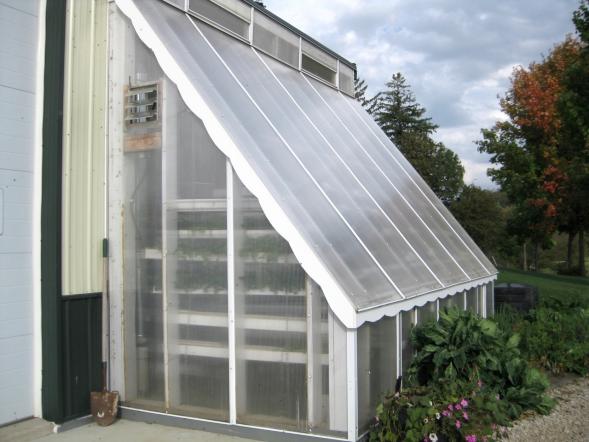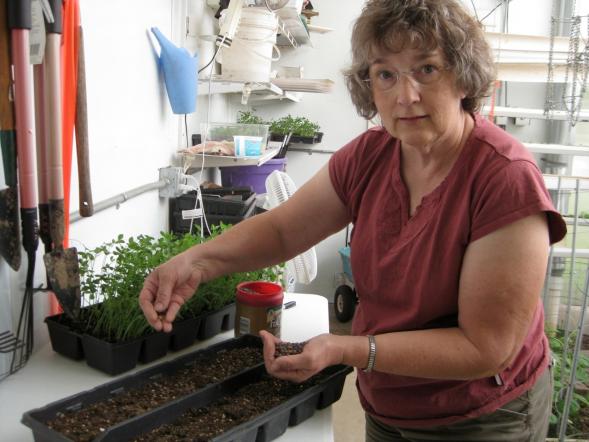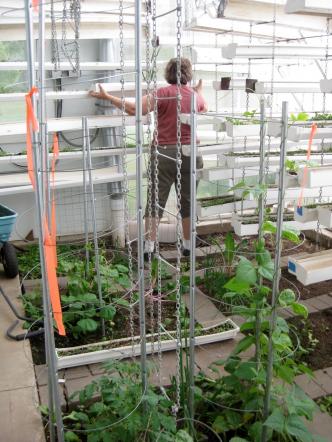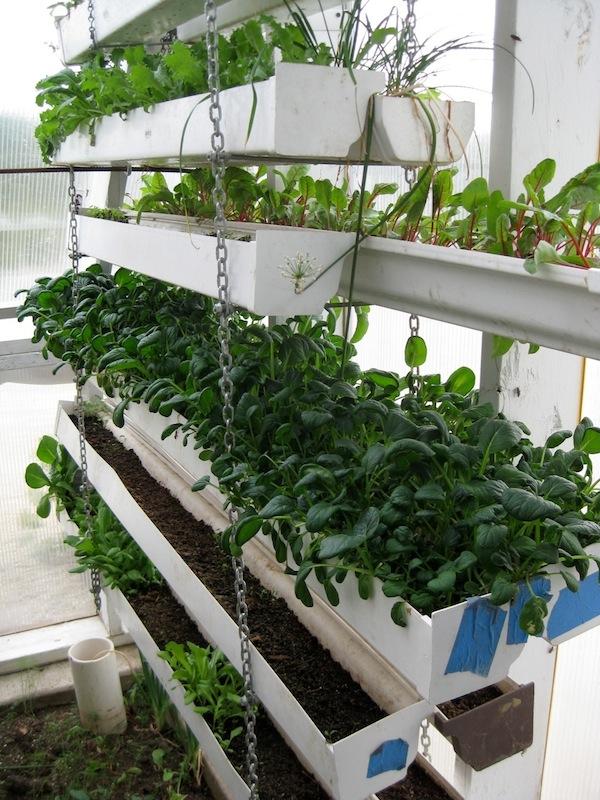It started with a roadtrip from Southeastern Minnesota, headed west, nearly to the South Dakota border. My sister, Liz Belina, a curious and inventive gardener, had already created a very productive series of raised garden beds outside her back door in rural Peterson, Minnesota. But Liz is a gardener who looks for ways to push the limits of her Zone 4 climate. So when she heard about a tour of an energy-efficient winter greenhouse – one that could be built with materials readily available from a hardware store, heated almost exclusively with stored passive solar energy, and allow her to grow salad greens all winter long – she had to know more.
Our destination? An innovative greenhouse in Milan, Minnesota, run by Chuck Waibel and Carol Ford. To add a winter source of leafy greens to their CSA offering, Chuck and Carol designed a stored passive solar winter greenhouse and built it onto their existing garage. They then offered tours and published a how-to manual to help others build similar energy-efficient growing spaces. Liz and I drove out for the tour, and within the year, Liz and her husband Mike decided to build a new garage which would include Liz's own version of an attached winter greenhouse.
 Exterior of Stored Solar Passive GreenhouseLiz’s winter greenhouse features a passive solar
design that uses simple low-tech
elements. The greenhouse uses double polycarbonate panels (a type of double-walled
plexiglass) to drink in radiant heat and minimize heat loss. Stovepipe sections along the peak of the steeply sloped ceiling use
inline fans to drive hot air down through a manifold of perforated plastic
tiling into an 18-inch-deep river rock heat sink that lies beneath the bed of soil
in the greenhouse. The inline fans trigger automatically when the sun warms the
greenhouse above 70 degrees. The river rock heat sink holds and slowly releases
heat through the colder hours of night. In addition, Liz designed her
greenhouse with geothermal lines imbedded in a cement strip along the back wall
of her greenhouse, an area that gets the least sunshine. A geothermal system
had already been installed to heat the house and was expanded for the new
garage, so it was easy to include it as a heat boost for the greenhouse. This
trickle of constant warmth helps assure a good catch each time Liz starts
greens from seed.
Exterior of Stored Solar Passive GreenhouseLiz’s winter greenhouse features a passive solar
design that uses simple low-tech
elements. The greenhouse uses double polycarbonate panels (a type of double-walled
plexiglass) to drink in radiant heat and minimize heat loss. Stovepipe sections along the peak of the steeply sloped ceiling use
inline fans to drive hot air down through a manifold of perforated plastic
tiling into an 18-inch-deep river rock heat sink that lies beneath the bed of soil
in the greenhouse. The inline fans trigger automatically when the sun warms the
greenhouse above 70 degrees. The river rock heat sink holds and slowly releases
heat through the colder hours of night. In addition, Liz designed her
greenhouse with geothermal lines imbedded in a cement strip along the back wall
of her greenhouse, an area that gets the least sunshine. A geothermal system
had already been installed to heat the house and was expanded for the new
garage, so it was easy to include it as a heat boost for the greenhouse. This
trickle of constant warmth helps assure a good catch each time Liz starts
greens from seed.
Over the past two winters, Liz has learned the art of harvesting sunlight to heat her greenhouse all winter. Now getting a start on her third winter, she knows how to head off problems with mold and bugs while optimizing the growing cycle of her leafy greens and keeping up with the continuous demand to keep planting more trays for each one she retires.
 Planting Rain Gutter Trays“I try to average four trays a day, as I start
the greenhouse up,” Liz explained her planting method as she measured out seed
from a large bulk bag, then sprinkled and patted the seeds into a 4-foot
section of ordinary rain guttering. “I’ve planted about a third of the available
space,” she said, setting the just-planted gutter on a heat pad that speeds
germination, taking a newly germinated tray to hang from a system of graduated
chain and positioning it for optimal sun exposure. Watering is the biggest
challenge, Liz said. Too much moisture causes mold. Too little, holds back
growth.
Planting Rain Gutter Trays“I try to average four trays a day, as I start
the greenhouse up,” Liz explained her planting method as she measured out seed
from a large bulk bag, then sprinkled and patted the seeds into a 4-foot
section of ordinary rain guttering. “I’ve planted about a third of the available
space,” she said, setting the just-planted gutter on a heat pad that speeds
germination, taking a newly germinated tray to hang from a system of graduated
chain and positioning it for optimal sun exposure. Watering is the biggest
challenge, Liz said. Too much moisture causes mold. Too little, holds back
growth.
On Wednesdays, Liz picks and bags greens for sale at Lanesboro Local Marketplace. Getting a customer following has taken time, but once locals discovered her greens (mustards, arugulas, tatsoi, mache, kales, chard, beet, cilantro, parsley, dill and a couple dozen other leafy greens) the supply nearly always sells out. Unlike spring mixes that ship from the West Coast and have a very short shelf life, Liz’s greens are winter-hardy varieties that arrive only hours after picking and easily outlast the trucked greens by a week.
In addition to growing produce to sell at the market, she also donates produce to the Rushford-Peterson school. Over the past couple years, she has watched the school food service shift from skepticism about prep work and concerns about student acceptance to enthusiastic appreciation each time she shows up with another batch of greens. Since new USDA standards took effect in January of 2011, Liz notes, “it's good to see kids eating fresh salads instead of canned fruit in corn syrup or ketchup as their vegetable.”
 Hanging Trays for Optimal SunAlways looking for ways to improve the growing
cycle, Liz rearranged the system this year to get her hanging trays closer to
the windows, so that each tray would get more exposure. Swapping the
nitrogen-fixed soil of the pea vines with that of nitrogen-depleting varieties
is another tweak for her process. She said she would also like to experiment
with willow bark tea and nettles, referring to a fertilizer tip said to improve
plant’s ability to take in moisture and nutritents.
Hanging Trays for Optimal SunAlways looking for ways to improve the growing
cycle, Liz rearranged the system this year to get her hanging trays closer to
the windows, so that each tray would get more exposure. Swapping the
nitrogen-fixed soil of the pea vines with that of nitrogen-depleting varieties
is another tweak for her process. She said she would also like to experiment
with willow bark tea and nettles, referring to a fertilizer tip said to improve
plant’s ability to take in moisture and nutritents.
Liz encourages others to join her inventive winter gardening system, in order to increase the supply of locally grown greens available through the coldest months of the year. “Anyone interested in this type of gardening is welcome to call and arrange to see my set-up,” she said.
To learn more about winter greenhousing, check out The Northlands Winter Greenhouse Manual by Carol Ford & Chuck Waibel or comment below to request Liz Belina's contact information to arrange a small group tour.
 Kitty Baker grew
up on a mixed ag farm, then in a small town, near Rochester, MN. She
and husband Keith raised two daughters, living in Kansas City and
Minneapolis. A professional writer, Kitty enjoys topics of lifestyle and
food, especially since 1999, when they bought a farm, Root River Wilds,
just north of Lanesboro, MN. The farm’s spectacularly varied acreage --
bluffs and woods, pastures and restored prairies cut with trails and
wrapped in the oxbow of the North Branch of the Root River -- is rich
with opportunities to discover and share ways to live abundantly. Her
last article for SGT was: Raising Chickens: A Respectful Butchering.
Kitty Baker grew
up on a mixed ag farm, then in a small town, near Rochester, MN. She
and husband Keith raised two daughters, living in Kansas City and
Minneapolis. A professional writer, Kitty enjoys topics of lifestyle and
food, especially since 1999, when they bought a farm, Root River Wilds,
just north of Lanesboro, MN. The farm’s spectacularly varied acreage --
bluffs and woods, pastures and restored prairies cut with trails and
wrapped in the oxbow of the North Branch of the Root River -- is rich
with opportunities to discover and share ways to live abundantly. Her
last article for SGT was: Raising Chickens: A Respectful Butchering.

